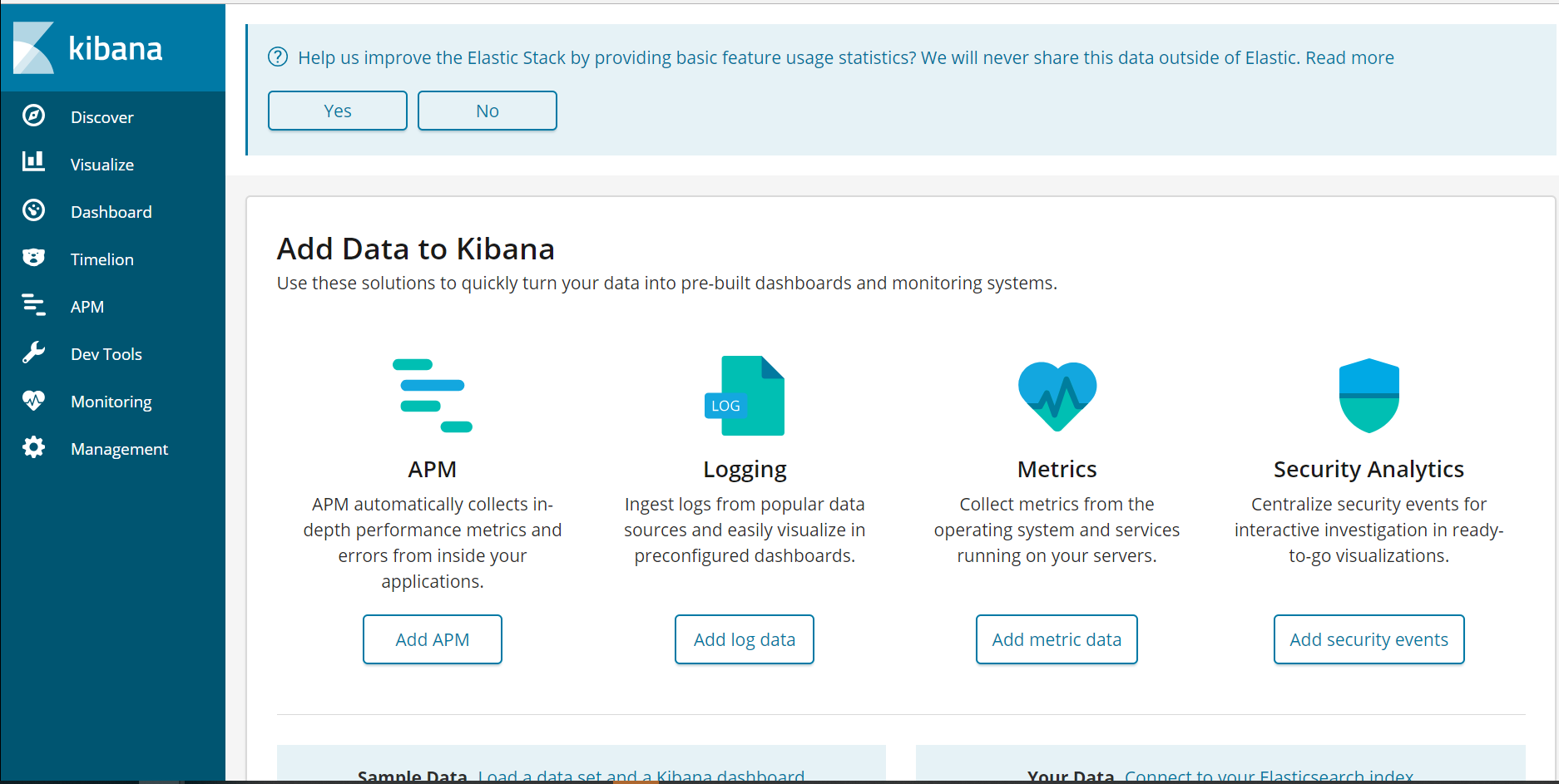Asp.net Core + Log4net + ELK 搭建日志中心
原文:Asp.net Core + Log4net + ELK 搭建日志中心
Docker中一键安装ELK
对于这种工具类的东西,第一步就直接到docker的hub中查找了,很幸运,不仅有Elasticsearch,kibana,logstash 单独的镜像,而且还直接 有ELK的镜像。
sudo docker run -p 5601:5601 -p 9200:9200 -p 5044:5044 -d --name log-platform --restart always sebp/elk
这当然能少好多配置,毫不犹豫就选择了elk的镜像, 运行起来!如果没有异常的话相信就很容易的跑起来了(最有可能出现的问题就是虚拟内存不足了,可以百度找解决方案这里就不在详细说了)
项目中添加log4net到Elasticseach的Appender
因为在.net core 之前就有搭建过日志中心,所以对于appender还记得有一个Log4net.Elasticsearch的dll,但是在查看资料之后发现很久没有更新 也不支持.net standard。在决定自己实现appender之前,抱着侥幸心理去查找了一翻,既然找到一个支持.net core的开源项目log4stash。很幸运,又可以不要造轮子了,哈哈。log4Stash使用很简单,但是配置的东西还挺多的而且作者也没有很好的文档介绍,先不管其他的用起来在说。
- 项目中添加log4stash
Install-Package log4stash -Version 2.2.1- 修改log4net.config
在log4net.config中添加appender
<appender name="ElasticSearchAppender" type="log4stash.ElasticSearchAppender, log4stash">
<Server>localhost</Server>
<Port>9200</Port>
<IndexName>log_test_%{+yyyy-MM-dd}</IndexName>
<IndexType>LogEvent</IndexType>
<Bulksize>2000</Bulksize>
<BulkIdleTimeout>10000</BulkIdleTimeout>
<IndexAsync>True</IndexAsync>
</appender>另外附上全部的配置信息
<appender name="ElasticSearchAppender" type="log4stash.ElasticSearchAppender, log4stash">
<Server>localhost</Server>
<Port>9200</Port>
<!-- optional: in case elasticsearch is located behind a reverse proxy the URL is like http://Server:Port/Path, default = empty string -->
<Path>/es5</Path>
<IndexName>log_test_%{+yyyy-MM-dd}</IndexName>
<IndexType>LogEvent</IndexType>
<Bulksize>2000</Bulksize>
<BulkIdleTimeout>10000</BulkIdleTimeout>
<IndexAsync>False</IndexAsync>
<DocumentIdSource>IdSource</DocumentIdSource> <!-- obsolete! use IndexOperationParams -->
<!-- Serialize log object as json (default is true).
-- This in case you log the object this way: `logger.Debug(obj);` and not: `logger.Debug("string");` -->
<SerializeObjects>True</SerializeObjects>
<!-- optional: elasticsearch timeout for the request, default = 10000 -->
<ElasticSearchTimeout>10000</ElasticSearchTimeout>
<!--You can add parameters to the request to control the parameters sent to ElasticSearch.
for example, as you can see here, you can add a routing specification to the appender.
The Key is the key to be added to the request, and the value is the parameter's name in the log event properties.-->
<IndexOperationParams>
<Parameter>
<Key>_routing</Key>
<Value>%{RoutingSource}</Value>
</Parameter>
<Parameter>
<Key>_id</Key>
<Value>%{IdSource}</Value>
</Parameter>
<Parameter>
<Key>key</Key>
<Value>value</Value>
</Parameter>
</IndexOperationParams>
<!-- for more information read about log4net.Core.FixFlags -->
<FixedFields>Partial</FixedFields>
<Template>
<Name>templateName</Name>
<FileName>path2template.json</FileName>
</Template>
<!--Only one credential type can used at once-->
<!--Here we list all possible types-->
<AuthenticationMethod>
<!--For basic authentication purposes-->
<Basic>
<Username>Username</Username>
<Password>Password</Password>
</Basic>
<!--For AWS ElasticSearch service-->
<Aws>
<Aws4SignerSecretKey>Secret</Aws4SignerSecretKey>
<Aws4SignerAccessKey>AccessKey</Aws4SignerAccessKey>
<Aws4SignerRegion>Region</Aws4SignerRegion>
</Aws>
</AuthenticationMethod>
<!-- all filters goes in ElasticFilters tag -->
<ElasticFilters>
<Add>
<Key>@type</Key>
<Value>Special</Value>
</Add>
<!-- using the @type value from the previous filter -->
<Add>
<Key>SmartValue</Key>
<Value>the type is %{@type}</Value>
</Add>
<Remove>
<Key>@type</Key>
</Remove>
<!-- you can load custom filters like I do here -->
<Filter type="log4stash.Filters.RenameKeyFilter, log4stash">
<Key>SmartValue</Key>
<RenameTo>SmartValue2</RenameTo>
</Filter>
<!-- converts a json object to fields in the document -->
<Json>
<SourceKey>JsonRaw</SourceKey>
<FlattenJson>false</FlattenJson>
<!-- the separator property is only relevant when setting the FlattenJson property to 'true' -->
<Separator>_</Separator>
</Json>
<!-- converts an xml object to fields in the document -->
<Xml>
<SourceKey>XmlRaw</SourceKey>
<FlattenXml>false</FlattenXml>
</Xml>
<!-- kv and grok filters similar to logstash's filters -->
<Kv>
<SourceKey>Message</SourceKey>
<ValueSplit>:=</ValueSplit>
<FieldSplit> ,</FieldSplit>
</kv>
<Grok>
<SourceKey>Message</SourceKey>
<Pattern>the message is %{WORD:Message} and guid %{UUID:the_guid}</Pattern>
<Overwrite>true</Overwrite>
</Grok>
<!-- Convert string like: "1,2, 45 9" into array of numbers [1,2,45,9] -->
<ConvertToArray>
<SourceKey>someIds</SourceKey>
<!-- The separators (space and comma) -->
<Seperators>, </Seperators>
</ConvertToArray>
<Convert>
<!-- convert given key to string -->
<ToString>shouldBeString</ToString>
<!-- same as ConvertToArray. Just for convenience -->
<ToArray>
<SourceKey>anotherIds</SourceKey>
</ToArray>
</Convert>
</ElasticFilters>
</appender>最后别忘了在root中添加上appender
<root>
<level value="WARN" />
<appender-ref ref="ElasticSearchAppender" />
</root>OK,项目的配置就到这里结束了,可以运行项目写入一些测试的日志了。
在kibana建立Index Pattern
Elasticsearch的Index跟关系数据库中的Database挺类似的,虽然我们项目在写了测试数据后,Elasticsearch中就已经有Index了,但是如果我们需要在可视化工具中查询数据的话建立Index Pattern
进入Management - Create Index Pattern,输入我们项目日志配置文件中的Index名称log_test-*(如果有数据,这边应该是会自动带出来的),然后创建,之后就可以在Kibana中浏览,查询我们的日志信息了。
Asp.net Core + Log4net + ELK 搭建日志中心的更多相关文章
- .NetCore快速搭建ELK分布式日志中心
懒人必备:.NetCore快速搭建ELK分布式日志中心 该篇内容由个人博客点击跳转同步更新!转载请注明出处! 前言 ELK是什么 它是一个分布式日志解决方案,是Logstash.Elastaics ...
- 2018年ElasticSearch6.2.2教程ELK搭建日志采集分析系统(教程详情)
章节一 2018年 ELK课程计划和效果演示1.课程安排和效果演示 简介:课程介绍和主要知识点说明,ES搜索接口演示,部署的ELK项目演示 es: localhost:9200 k ...
- ASP.NET Core扩展库之日志
上一篇我们对Xfrogcn.AspNetCore.Extensions扩展库功能进行了简单的介绍,从这一篇文章开始,我将逐步介绍扩展库中的核心功能. 日志作为非业务的通用领域基础功能, ...
- asp.net core结合NLog搭建ELK实时日志分析平台
0.整体架构 整体架构目录:ASP.NET Core分布式项目实战-目录 一.介绍ELK 1.说明(此篇ELK采用rpm的方式安装在服务器上)-牛刀小试 承接上一篇文章的内容准备部署ELK来展示asp ...
- Asp.Net Core中简单使用日志组件log4net
本文将简单介绍在.NET 6中使用log4net的方法,具体见下文范例. 1.首先新建一个ASP.NET Core空项目 2.通过Nuget包管理器安装下面两个包 log4net Microsoft. ...
- Asp.Net Core Log4Net 配置分多个文件记录日志(不同日志级别)
本文所有配置都是在core3.1环境下. 首先看看最终的效果. 请求监控:对每次请求的相关信息做一个记录. 全局异常:我不想我的错误信息,跟其他的信息混合在一起,查看的时候不大方便. 应用日志:这个主 ...
- ASP.NET Core MVC之Serilog日志处理,你了解多少?
前言 本节我们来看看ASP.NET Core MVC中比较常用的功能,对于导入和导出目前仍在探索中,项目需要自定义列合并,所以事先探索了如何在ASP.NET Core MVC进行导入.导出,更高级的内 ...
- asp.net core使用serilog将日志推送到腾讯云日志服务
为什么是serilog? Serilog是 .NET 中最著名的结构化日志类库. 基于日志事件log events,而不是日志消息log message. 你可以将日志事件格式化为控制台的可读文本或者 ...
- ASP.NET Core 使用 JWT 搭建分布式无状态身份验证系统
为什么使用 Jwt 最近,移动开发的劲头越来越足,学校搞的各种比赛都需要用手机 APP 来撑场面,所以,作为写后端的,很有必要改进一下以往的基于 Session 的身份认证方式了,理由如下: 移动端经 ...
随机推荐
- JPA 继承关系实现的三种方式
single table 一张表保存所有类型 join 扩展属性保存在子表中 TABLE_PER_CLASS 每个类型一张表
- tushare下载安装教程与版本更新步骤
使用前提 安装Python 安装pandas:pip install pandas 安装lxml:pip install lxml 下载安装 方式1:pip install tushare,如果安装网 ...
- python 包管理工具 pip 的配置
近几年来,python的包管理系统pip 越来越完善, 尤其是对于 windows场景下,pip大大改善了python的易用性. https://www.cnblogs.com/yvivid/p/pi ...
- pyhon if分支
在python中,最常用的就是if判断,if判断可以分为单次判断和多次判断 单次判断 if 条件 : (条件成立执行我) else:(else也可以没有,最近的else对应最近的if语句) (条件 ...
- js中构造函数的原型添加成员的两种方式
首先,js中给原型对象添加属性和方法. 方式一:对象的动态特效 给原型对象添加成员 语法:构造函数.prototype.方法名=function (){ } 方式二:替换原型对象(不是覆盖,而是替换, ...
- Linux解压rar文件
Linux解压rar文件(unrar安装和使用,分卷解压) windows平台很多压缩文档为rar文件,那么怎么做到Linux解压rar文件(unrar安装和使用)? 简单,centos5安装unra ...
- xfce4之whisker不显示自定义启动器的解决
对某些启动比较麻烦的程序,想创建个启动器显示在whisker里,这样就能快速启动了. 通常自己创建的desktop文件可以放~/.local/share/applications里,但是按下面这个创建 ...
- .NET WEB API 简单搭建
首先是注释问题: 找到 跟目录下Areas/HelpPage/App_Start/HelpPageConfig.cs 加上代码就OK 了 还有在解决方案属性 点击生成 将XML文档文件勾上 API ...
- ubuntu批量转换所有子文件夹下图片文件格式
第一步按照 sudo apt-get install imagemagick 对于一个文件,可以: convert ubuntuhandbook.png ubuntuhandbook.jpg 对于多个 ...
- visual studio 自定义警告标签
写代码中经常会遇见某段代码写的不大合适或者是有隐患,但是一时半会有没时间不去完善,总体上不影响程序,也就放下了 结果时间一久就给忘了 vs提供了自定义警告的功能,这样就能有个提醒啦,方便以后改进 us ...
